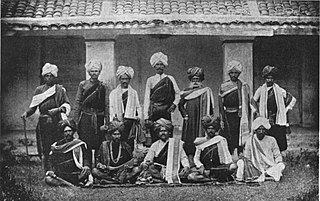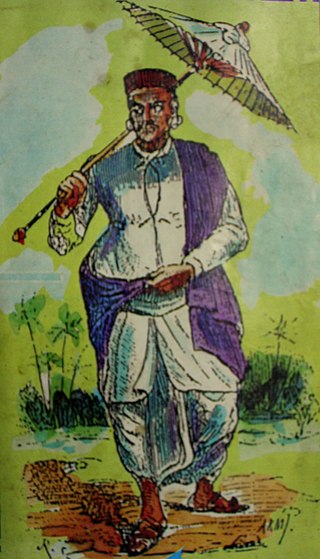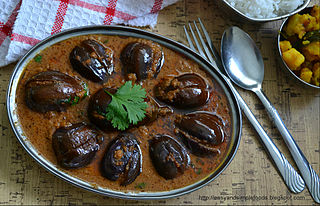Indian cuisine consists of a variety of regional and traditional cuisines native to India. Given the diversity in soil, climate, culture, ethnic groups, and occupations, these cuisines vary substantially and use locally available spices, herbs, vegetables, and fruits.

A dosa is a thin savory pancake in South Indian cuisine made from a fermented batter of ground black lentils and rice. Dosas are served hot, often with chutney and sambar. Dosa is a signature dish in South India and Sri Lanka, and is popularly served in their respective restaurants around the world.

Singh is a title, middle name or surname that means "lion" in various South Asian and Southeast Asian communities. Traditionally used by the Hindu Kshatriya community, it was later mandated in the late 17th century by Guru Gobind Singh for all male Sikhs as well, in part as a rejection of caste-based prejudice and to emulate Rajput naming conventions. As a surname or a middle name, it is now found throughout the world across communities and religious groups, becoming more of a generic, caste neutral, decorative name.
Saraswat Brahmins are Hindu Brahmins, who are spread over widely separated regions spanning from Kashmir in North India to Konkan in West India to Kanara and Kerala in South India. The word Saraswat is derived from the Rigvedic Sarasvati River.

Kunbi is a generic term applied to castes of traditional farmers in Western India. These include the Dhonoje, Ghatole, Masaram, Hindre, Jadav, Jhare, Khaire, Lewa, Lonare and Tirole communities of Vidarbha. The communities are largely found in the state of Maharashtra but also exist in the states of Madhya Pradesh, Gujarat, Karnataka, Kerala and Goa. Kunbis are included among the Other Backward Classes (OBC) in Maharashtra.
Bunt is an Indian community, who traditionally inhabit the coastal districts of Karnataka and Kasaragod District of Kerala State. Bunts were originally a warrior class community with agrarian origins, and form the landed gentry of the region. They are the dominant, land-owning farming community of Tulu Nadu and speak Tulu as well as Kundagannada as their mother tongue. The Bunts today are a largely urbanised community with a population size of less than 1 million worldwide.
The Dhangars are a herding caste of people found in the Indian states of Maharashtra, Karnataka, Goa, Madhya Pradesh and Uttar Pradesh. They are referred as Gavli in southern Maharashtra, Goa and northern Karnataka, Golla in Andhra Pradesh and Karnataka and Ahir in northern Maharashtra. Some Gavlis live in forested hill tracts of India's Western Ghats. Gavli, also known as Dange or Mhaske, and Ahir are a sub-caste of Dhangar. However, there are many distinct Gavli castes in Maharashtra and Dhangar Gavli is one of them.
Hegde or Heggade Pergade is a common surname found primarily in the Kanara, Tulu Nadu and Konkan regions of India. It is prevalent among various Hindu communities in these regions, including the Kuruba Gowda, Bunt, Saraswat Brahmins, Kannada Jain, Havyaka Brahmin, and Vokkaliga communities of Karnataka.
Maharashtrian or Marathicuisine is the cuisine of the Marathi people from the Indian state of Maharashtra. It has distinctive attributes, while sharing much with other Indian cuisines. Traditionally, Maharashtrians have considered their food to be more austere than others.
Indian names are based on a variety of systems and naming conventions, which vary from region to region. In Indian culture, names hold profound significance and play a crucial role in an individual's life. The importance of names is deeply rooted in the country's diverse and ancient cultural heritage. Names are also influenced by religion and caste and may come from epics. In Hindu culture, names are often chosen based on astrological and numerological principles. It is believed that a person's name can influence their destiny, and selecting the right name is essential for a prosperous and harmonious life. Astrologers may be consulted to ensure a name aligns with the individual's birth chart.India's population speaks a wide variety of languages and nearly every major religion in the world has a following in India. This variety makes for subtle, often confusing, differences in names and naming styles. Due to historical Indian cultural influences, several names across South and Southeast Asia are influenced by or adapted from Indian names or words.
Udupi cuisine is a cuisine of South India. It forms an important part of Tuluva cuisine and takes its name from Udupi, a city on the southwest coast of India in the Tulunadu region of the state of Karnataka. Udupi cuisine is strictly vegetarian and has its origin in the Udupi Sri Krishna Matha founded by Madhvacharya. The cuisine was developed by Madhva Brahmins to offer different kinds of food to Krishna at the Udupi Krishna Temple. Hence, Udupi cuisine is also synonymously known as Madhva cuisine.

Vokkaliga is a community, or a group of closely related castes, from the Indian state of Karnataka. They are also present in the neighbouring state of Tamil Nadu.
The Nayak, or Naik is a historic Indian title conferred on military generals and governors of feudal states in the Middle Ages. Today it is also a surname. Nayaks are mostly Hindu and few Sikhs, who follow Hinduism and Sikhism respectively.

Gaud Saraswat Brahmins (GSB) are a Hindu Brahmin community, who are part of the larger Saraswat Brahmin community that migrated to Konkan from Gaud, as per the Skanda Purana in ancient India. They belong to the Pancha Gauda Brahmins group.They primarily speak Konkani and its various dialects as their mother tongue.
Tyagi originally called Taga, is a cultivator caste who claim Brahmin status. The landholding community is confined to Western Uttar Pradesh, Haryana, Delhi and Rajasthan. They are often considered the highest of the agricultural castes. During the British Raj, they changed their name from Taga to Tyagi, and began claiming Brahmin status. As of a 1990 report by the Backward Classes Commission, Government of Haryana, they were mostly engaged in farming. The Government of Haryana granted reservation to Tyagis along with five other castes in 2016. However, the Punjab and Haryana High Court shortly put a stay on the government's order.

The Daivadnyas,, are a Konkani community, who claim to have descended from Vishwakarma, Hindu architect god and part of larger Vishwakarma community. They are native to the Konkan and are mainly found in the states of Goa and Damaon, Canara, coastal Maharashtra, and Kerala.

Maharashtra is the third largest state of India in terms of land area and second largest in terms of population in India. It has a long history of Marathi saints of Varakari religious movement, such as Dnyaneshwar, Namdev, Chokhamela, Eknath and Tukaram which forms the one of bases of the culture of Maharashtra or Marathi culture. Maharashtra had huge influence over India under the 17th-century king Chatrapati Shivaji Maharaj of the Maratha Empire and his concept of Hindavi Swarajya which translates to self-rule of people.

Kuḻambu, is a common dish in Tamil Nadu and Sri Lankan cuisines, and is a tamarind-based dish that can include a variety of meat, vegetables, and in some cases, dal.

Madhva Brahmins, are Hindu Brahmin communities in India, who follow Sat Vaishnavism and Dvaita philosophy propounded by Madhvacharya. They are found mostly in the Indian states of Karnataka, Maharashtra, Goa, Tamil Nadu, Kerala, Telangana and Andhra Pradesh.
The Rajapura Saraswat is a Hindu community in Maharashtra, Kerala and Karnataka. They are also known as Rajpuri or Rajapur.









